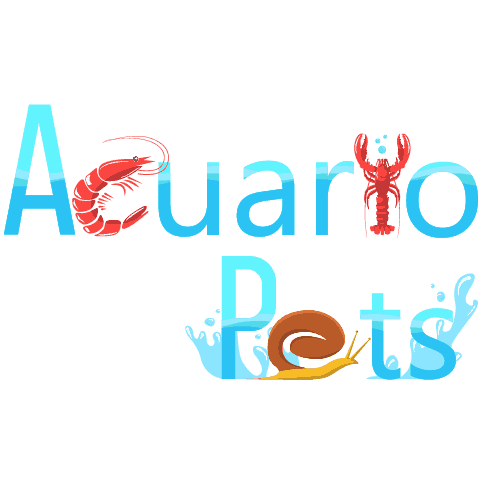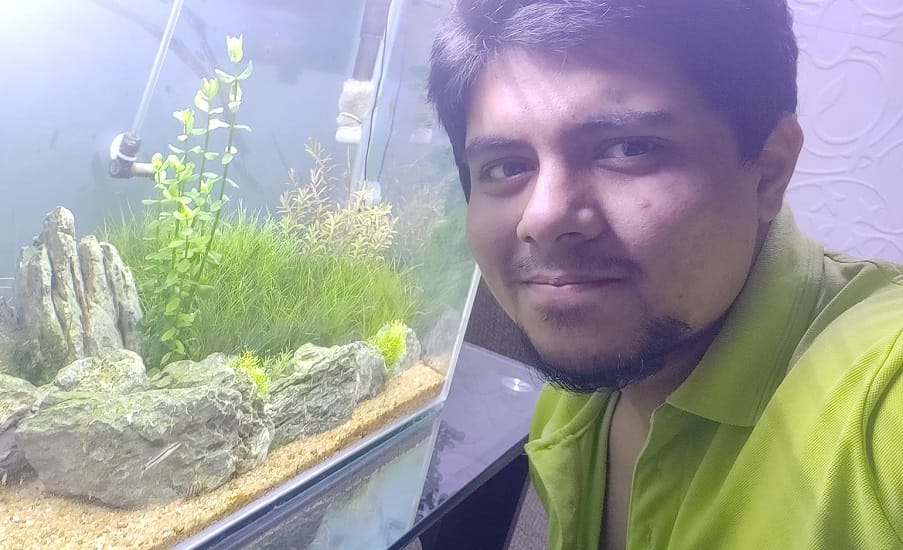Why Is My Leopard Gecko Trying To Escape?
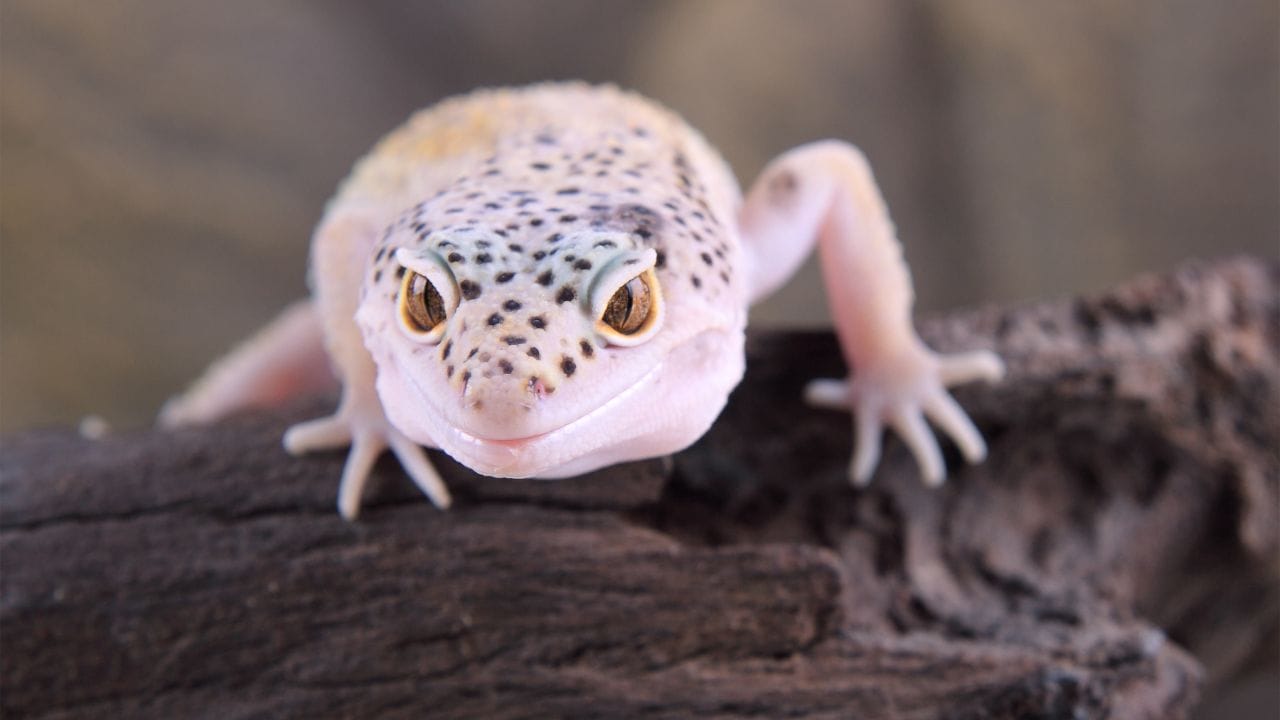
When you own a Leopard Gecko, you definitely need it to be with you for as long as possible. However, there might be times when you see your Gecko trying to escape from its enclosure. Maybe that time, you might think – why is your Leopard Gecko trying to escape?
Your Leopard Gecko might try to escape because of stress, fear, hunger, fluctuation in temperature, dirty and small enclosure, and more. This is a common situation in all Geckos and they try to escape to find a place where they can feel comfortable and less threatened.
If you want to know more about this strange behavior of your Gecko, make sure to stick with me till the end!
Reasons Why Your Leopard Gecko Is Trying To Escape
Leopard Geckos do not usually try to escape or hide. Most of the time they love to interact with their owners when they cope with the environment. Hence, if you see your Gecko escaping most of the time, it could be because your Gecko is having some issues.
There are multiple reasons why you might see your Gecko trying to escape.
- New environment
- Dirty enclosure
- The new and alive creature in the tank
- Small tank
- Excessive temperature
- Less hiding places
New Environment
Even though escaping is not a feature of Gecko, it is actually normal when you introduce your Gecko to a new environment. As Leopard Geckos are not used to living in an artificial environment, seeing things from a different angle might make them a bit uncomfortable at first.
This behavior is totally fine and you may see your Gecko hiding inside its hiding spot and may not come near to you that much as well.
In such cases, the only thing you can do is to wait for your Gecko to build up a connection with you. Remember that force is going to make things worse. You need to be patient while handling your Gecko as well.
Sometimes handling too much can make your Gecko uncomfortable and it might try to escape to hide from you as well. Be very gentle and polite with it and make sure that its enclosure is clean and spacious enough for it to roam around freely.
Dirty enclosure
Nobody likes a dirty environment, and Gecko is one of the creatures. Sometimes owners do not clean or forget to clean Gecko’s tank on a weekly or monthly basis. This makes Gecko’s tank filled with filth.
Not only this, but sometimes your Gecko might poop or pee inside its hiding spot which without cleaning can become dirtier with time. The tank may start to smell and your Gecko will start to escape the enclosure too.
You need to keep your Gecko’s tank neat and clean every time. You may not do it regularly, but at least do it once a week or go for deep cleaning. These processes will help you create a healthy and safer place for your Gecko to settle in.
A dirty enclosure can not only hamper your Gecko’s lifestyle but also its health. Hence everything should be regulated perfectly.
The new and alive creature in the tank
Competing with other creatures is something Gecko would not do inside an artificial enclosure. Leopard Geckos are not social and they prefer to stay alone rather than be with another creature, even if it’s from its own breed.
Introducing a new Gecko inside the tank, irrespective of its gender can seriously affect your Gecko’s lifestyle.
Especially if your Gecko is male, it cannot tolerate the presence of another male in its tank and they both may end up hurting each other badly causing death as an ultimate action.
Also sometimes, if you give your Gecko alive insects by mistake, the insects can attack your Gecko instead of being a food source to it. Hence always make sure to give nonalive or half-alive insects to your Gecko.
Small tank
There are different sizes of tanks available for the Leopard gecko but a 10-gallon size tank is the minimum size your Gecko needs.
Since Leopard Geckos generally roam around their habitat in nature, a smaller tank than their own size will make them suffocate. This suffocation will lead them to leaving or trying to escape from their tanks when they can.
Hence the size of the tank should be appropriate which is a minimum of 10 gallons. A big tank will allow your Gecko to roam around freely and allow you to create an artificial yet realistic environment for your Gecko to live in.
By the time your Gecko turns 2 months old, you need to start upgrading the tank size according to your Gecko’s needs.
Excessive temperature
Fluctuation in temperature is another big reason why your Gecko might try to escape. Most of the time owners forget to regulate the temperature of the enclosure.
Normally the temperature of the Leopard gecko’s tank needs to be between 77-90℉. This temperature helps Gecko to regulate food and their metabolism process works great just as in nature. But the basking temperature can be between 94 and 97℉ whereas at night it should not drop down below 60℉.
If the temperature is too high, your Leopard Gecko will soon suffocate and burn to death. In the cold atmosphere, your Leopard gecko will face metabolism issues as their metabolism process will slow down due to the drop in temperature.
This unfriendly environment will lead your Gecko to escape the tank whenever it’s possible. Hence make sure to keep an optimum temperature range for your Gecko.
Less hiding places
Geckos are not very social reptiles which also makes them introverted creatures who love to hide in their places.
Generally, when you build a tank for your Gecko, you must ensure that the tank contains at least three hiding places: one on the cooler side, one on the warm side, and another one for shedding.
These hiding places will help your Gecko to feel more comfortable and safer around every creature, including you.
However, in absence of these hiding places, your Gecko may end up being scared due to getting overly exposed, and as a result, it will try to escape the tank immediately.
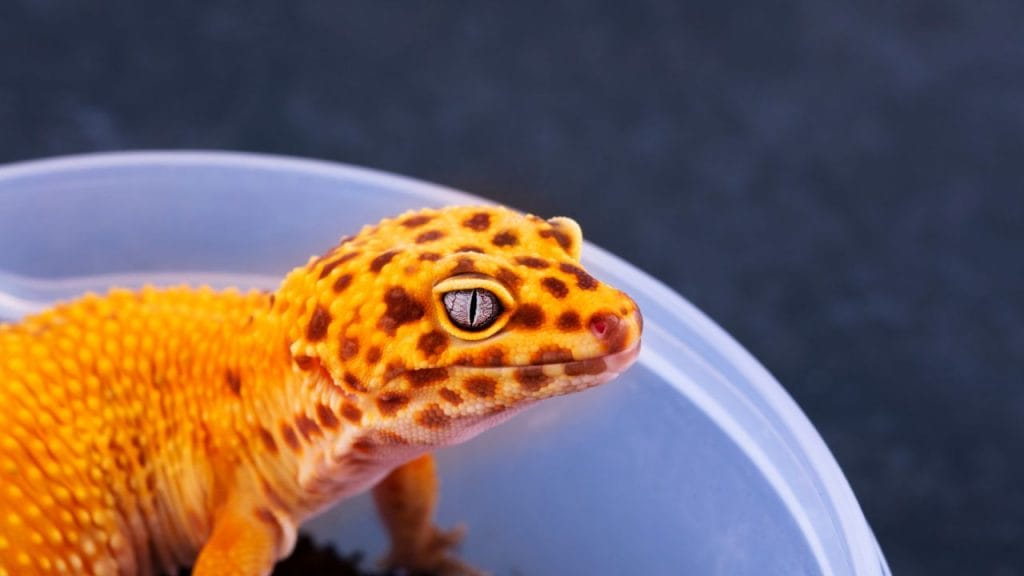
Why Does My Leopard Gecko Climb?
Leopard Geckos do have the habit of climbing and sometimes they do it to escape from the enclosure. Most of the time, Leopard Geckos climb for three reasons:
- Your Gecko is enjoying the high grounds
- Your Gecko is doing Glass surfing
- Your Gecko is trying to escape
Your Gecko is enjoying the high grounds
If you decorate the enclosure with big rocks or trees and you see your Gecko trying to climb that, it means your Leopard Gecko is enjoying its surroundings.
Leopard Geckos do get a lot of space in nature to climb and explore. But inside an artificial tank, they do not have a lot of things to explore.
Hence you can put some of the trees or big rocks or anything that is slightly above the ground. This will help your Gecko to explore the whole tank and it will enjoy being inside the artificial space.
But you need to be very careful choosing any trees or rocks as sometimes these may contain sharp edges that can severely injure your Leopard Gecko or its eyes. Hence make sure that whatever elements you choose to put inside the tank do not have sharp edges.
Your Gecko is doing Glass surfing
Glass surfing is basically seeing your Gecko climbing through the glass of the enclosure. This is a common phenomenon and it can happen if your Leopard Gecko is bored, afraid of anything in the tank, or feels uncomfortable.
If you see your Leopard Gecko is glass surfing, you need to first check its enclosure. Most of the time when the enclosure is filthy or has the presence of another creature, your Leopard Gecko will repeat the same behavior. Hence you always need to keep the tank clean and tidy.
Your Gecko is trying to escape
If you see your Gecko climbing the glass wall very often, it might be due to their escaping process. Most of the time when your Gecko starts to feel uncomfortable, it tries to move out of the enclosure.
Generally, Geckos are very friendly and they do try to interact with their wonders as much as they can. But Geckos do not like to be handled or bothered that much. Whenever you try to handle your Gecko when it’s uncomfortable, it will tend to run away or escape from that place.
Also if the enclosure is dirty or has other living creatures inside it, it’s evident that your Gecko will not like it and will also try to escape whenever it can.
What Do I Do If My Leopard Gecko Escapes?
There might be an unfortunate time when you may see that your Gecko is nowhere to be found. This is not an everyday situation and it is a matter of concern. However, if you see that your Gecko is missing, you can follow some steps:
- Stop panicking
- Check the hiding spots
- Check the ground of your house
- Check the warm spots
- Clear the entire floor
- Check your shoes
Stop panicking
Panicking in these situations is very normal However panicking will not help but rather make things worse.
Most of the time when owners panic, they tend to check a few areas where their Gecko might actually hide. This makes the situation worse as their Gecko escapes from the house by the time or gets attacked by predators.
This is why make sure to be very patient and calm as much as possible. Think of the possible places you can find it, such as dark, warm, or any hiding places. Make a list of it and start searching for your Leopard Gecko.
Check the hiding spots
Hiding spots inside the enclosure are another place you should probably check before you search your Gecko outside.
Sometimes owners do not go through all hiding spots thinking your Gecko might have gone outside the tank.
But Geckos might be hiding inside their hiding spots when they are afraid or not comfortable meeting with new people. They can also hide when they are going through shedding or when they are introduced to a new environment.
Hence look inside all the hiding spots but make sure to wash your hands before looking inside using your hands. Otherwise, it can lead to the transfer of contaminants inside the enclosure.
Also, do not use any sharp-edged stick or anything sharp to find inside the hiding spots. This can seriously injure your Gecko.
Check the ground of your house
Leopard Geckos are not creatures that love to do wall surfing. They only climb the wall when they feel threatened or uncomfortable in their environment. Hence there is a huge chance that you will find your Gecko mostly on the floor. You can use a light with low power to find your Gecko if it’s night time, as most Leopard geckos get active at that time. Hence there might be a chance that it comes outside and thus you can find it.
Also, look under the bed, or any place where the lights do not reach generally. Your Gecko might hide there to protect itself from any predators.
But be very careful while looking under furniture if you drag the furniture harshly, there is a possibility that you may squish your Gecko within seconds. Better if you lift the furniture to another place rather than dragging it.
Check the warm spots
Leopard Geckos are cold-blooded creatures, meaning they love warmth most of the time. Hence you should look under the refrigerator or near the areas that receive heat. You can look around the heaters as well.
When in the daytime, you can also look for your Gecko in places where the sun shines directly. As Leopard Geckos need heat to survive, they will need a source of heat that can do that instead of UV light.
Clear the entire floor
There are a few times when you might need to clean the entire floor of your house to look for your Gecko. Your Gecko might try to hide in boxes, shoes, under the matt, and whatnot. In such cases, you need to look through everything to try to clean the floor gently.
Before doing this process, make sure to close all the doors or escape places so that your Gecko does not run away while you look for it.
Also do not choose any sharp objects or objects with rough edges. This can cause injuries to your Gecko’s body very easily.
Check your shoes
Leopard Geckos love warmth and shoes can be a good hiding spot for them. As shoes are warm and also it has that little darkness, your Gecko may consider hiding inside them just like insects do.
Hence if your gecko is lost, make sure to look inside the shoes as well. Be very careful before putting the shoes on as you may also squeeze them while wearing the shoes perfectly.
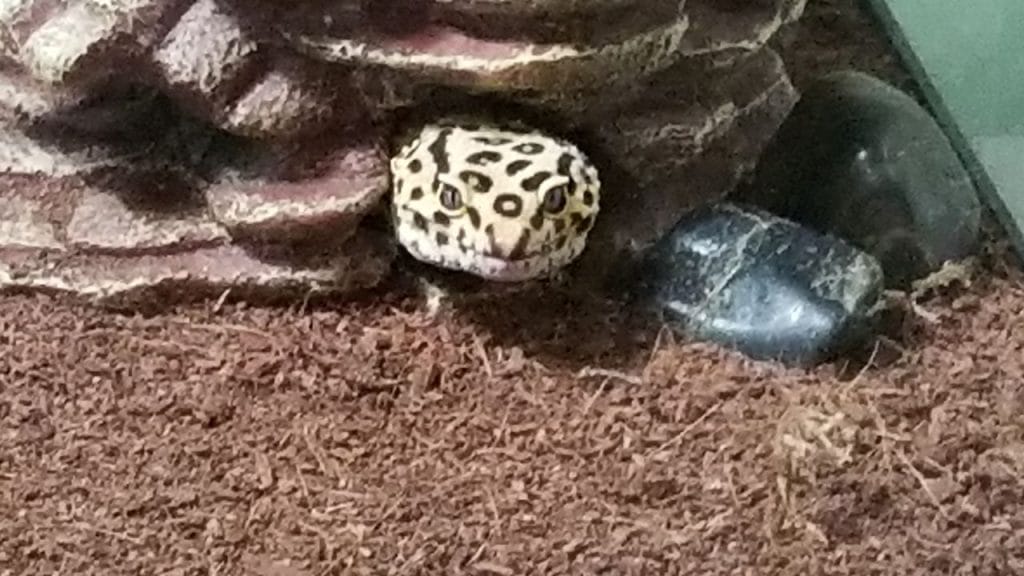
Why Is My Gecko Trying To Climb The Glass?
Climbing glass is something Leopard Geckos do when they want comfort and feel peace. This climbing is also called “Glass surfing” and there are a few reasons why your Gecko climbs the glass:
- Gecko is hungry
- Your Gecko is bored
- Gecko is exploring the environment
- Your Gecko is feeling stressed and scared
- Your Gecko trying to get heat from the light
Gecko is hungry
If your Gecko is hungry, it cannot speak, right? Hence your Gecko might try to glass surf or climb the glass to find enough food for itself.
This is a warning sign as most of the Geckos can live without food for a long time. But if you see that your Gecko is trying to get food by doing glass surfing, it can be because it’s not getting the amount of food it requires.
Hence you need to give more food to your Gecko to replenish its hunger.
Your Gecko is bored
Leopard geckos can glass surf when they are bored. This is a very natural thing. If the enclosure does not have enough decorations, it’s obvious that your Gecko will get bored with time and it will try to find a new place where it can get enough facilities.
Hence you need to decorate the entire enclosure with enough heat and humidity, hiding spots, substrate, etc. to make it beautiful and livable for your Gecko.
Gecko is exploring the environment
When you introduce your Gecko into a new terrarium, it may do glass surfing to explore the entire place. As sometimes it may need to climb rocks or other plants inside the enclosure, it may take the help of the wall to climb. This is also natural and you should not get worried about it.
Your Gecko is feeling stressed and scared
This is a common scenario that occurs most of the time. Geckos do not like to live with other creatures, even with their own breed.
Hence when you introduce a new Gecko inside its enclosure, especially if the other Gecko is bigger in size, your Gecko will definitely feel threatened and try to move away from that place as soon as possible.
This is why you should never introduce any other geckos unless you want your Gecko to mate.
Your Leopard gecko can also feel threatened if there are any alive insects present inside the enclosure. A lot of times, owners mistakenly do not kill the insects properly which later attacks the gut of the Gecko. Therefore, be very careful while providing insects to your Gecko.
Your Gecko trying to get heat from the light
If your Gecko does not get enough light or heat, it may try to go near the light by climbing through the glass. As the heat helps your Gecko to survive as Geckos are cold-blooded. Hence you can lower the lighting source a bit to help your Gecko get the heat sufficiently.
Final Words
Leopard Geckos do not usually try to escape from their enclosures. There are lots of reasons behind that. If you ever see your Gecko trying to escape, make sure to go through the mentioned reasons above.
Yet if your Leopard gecko escapes, do not panic and look for it by following the steps mentioned. Always try to provide a safe and comfortable environment for your Gecko. Then, they will never try to run away from you.
About Author
Hello, I’m Muntaseer Rahman, the owner of AcuarioPets.com. I’m passionate about aquarium pets like shrimps, snails, crabs, and crayfish. I’ve created this website to share my expertise and help you provide better care for these amazing pets.
Disclaimer
This site is owned and operated by Muntaseer Rahman. AcuarioPets.com is a participant in the Amazon Services LLC Associates Program, an affiliate advertising program designed to provide a means for sites to earn advertising fees by advertising and linking to Amazon.com. This site also participates in other affiliate programs and is compensated for referring traffic and business to these companies.
